平行极板电容传感器介电式颗粒饲料水分检测仪设计与试验
牛智有,刘芳宏,刘 鸣,任邹弘,李 培
平行极板电容传感器介电式颗粒饲料水分检测仪设计与试验
牛智有1,2,刘芳宏1,刘 鸣1,任邹弘1,李 培1
(1. 华中农业大学工学院,武汉 430070;2. 农业部长江中下游农业装备重点实验室,武汉 430070)
为了实现颗粒饲料含水率的快速、无损检测,设计了以STM32F103ZET6单片机为控制芯片的颗粒饲料水分检测仪,采用平行极板电容传感器、温度传感器、质量传感器和相应的检测电路分别检测颗粒饲料样品的电容、温度和容积密度,经过单片机进行处理后实现颗粒饲料的含水率检测,并在OLED显示屏上显示检测结果。采用自制颗粒饲料水分检测仪,分析了含水率、温度、容积密度对颗粒饲料相对介电常数的影响规律,并建立了相对介电常数与含水率、温度、容积密度之间的关系模型,模型的决定系数为0.996 8。同时对颗粒饲料水分检测仪的检测精度进行了检验,含水率实测值与仪器检测值之间的决定系数为0.990 3。试验结果表明,与烘干法相比,所设计检测仪的绝对测量误差值在±0.6%以内,具有一定的实用价值。该研究为颗粒饲料水分快速、无损在线检测提供一种新的方法和技术支撑。
无损检测;含水率;传感器;电容传感器;颗粒饲料;检测仪;介电特性
0 引 言
饲料是种植业和养殖业的重要联结,在农业产业链中居于关键地位[1]。经过四十多年的持续发展,中国成为世界上主要饲料生产大国之一,占世界总产量的20%[2]。颗粒饲料是饲料产品的主要物理形态,具有营养全面、稳定性好的特点[3-4]。含水率是颗粒饲料品质的基本指标,直接影响饲料产品的质量及其贮藏性能。颗粒饲料的含水率过高,会使其容易发霉变质,不利于保存,还会使营养成分的含量相对减少,降低了颗粒饲料的能量;颗粒饲料的含水率过低,会影响饲料口味并造成过大的重量损失[5-6]。因此,在颗粒饲料的加工、储存应用中,含水率的检测非常重要。
介电特性是表达不同生物体在不同环境中的差异性的物理参数之一,通过研究这一参数可以获得丰富的生物信息[7-9]。介电特性的研究覆盖了医药、地质、农业等众多领域,基于不同的研究目的,侧重点也有所差异。陈晓敏等[10]利用阻抗分析仪分析了频率为0.01~100 MHz下血液的介电参数与血液指标的关系。结果表明,血沉与血液介电参数呈线性相关。宋文等[11]利用时域有限差分法模拟出4种不同介电特性差异的土壤层次的土体模型,再结合雷达电磁波实现对潮土区农田土体构型层次的无损探测。边红霞等[12]利用万能试验机和平行板电极法测量了不同压力下苹果的介电参数。结果表明,苹果的相对介电常数和损耗因数会随着静压力的延长而增大,这为根据果品的介电特性快速评价其受伤程度提供了理论指导。
农业物料的介电特性主要应用于新鲜度检测[13-14]、分级筛选[15-16]、品种检测[17-18]、含水率预测[19-21]等领域。其中,基于介电特性的农业物料含水率预测是一种常见的、应用广泛的检测方法[22]。不同含水率的农业物料的介电特性不同,根据这一原理,国内外学者普遍采用通过测量农业物料的介电参数,建立与对应含水率的数学模型,从而达到预测农业物料水分的目的[23-25]。但是,仅考虑含水率对农业物料介电特性的影响,会降低数学模型精度,影响预测效果。因此,需要考虑温度、容积密度、含水率等因素对农业物料介电特性的影响。将这些因素融合处理,可以提高对农业物料含水率的检测精度[26-28]。
颗粒饲料含水率测定方法主要是烘干法。该方法虽然测量精度高,结果稳定,但测定过程繁琐,费工耗时,无法实现快速、无损测量[29]。目前,市场上已有的水分检测仪多适用于谷类作物及其他经济作物,尚未有专门用于测量颗粒饲料含水率的检测仪[30-33]。因此,为了实现颗粒饲料含水率的快速、无损检测,本文利用颗粒饲料的介电特性,研制一种基于介电特性的便携式颗粒饲料水分测定装置,旨在为颗粒饲料水分快速、无损在线检测提供一种新的方法和技术支撑。
1 颗粒饲料水分检测仪设计
1.1 总体系统结构与检测原理
颗粒饲料水分检测仪总体结构如图1所示。主要包含电容传感器、温度温度传感器、质量传感器和电路板保护壳等。电路板保护壳使用Creo4.0软件设计,尺寸为110 mm×110 mm×27 mm,用3D打印技术制作,耗材采用光敏树脂;温度传感器放置在电容传感器内,而电容传感器置于质量传感器上,质量传感器固定在电路板保护壳上。
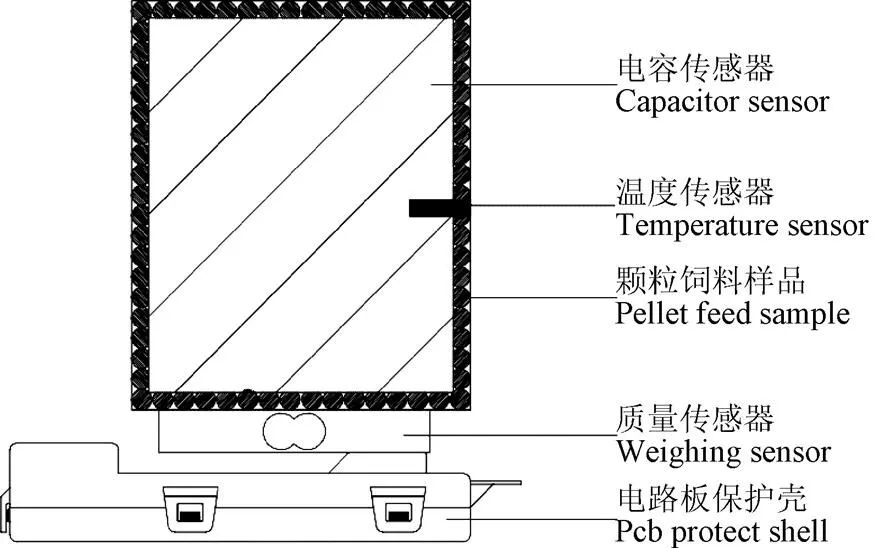
图1 颗粒饲料水分检测仪结构示意图
系统模块结构如图2所示主要包括单片机控制模块、电容传感器、质量传感器、温度传感器、电源模块、显示模块、按键电路等。

图2 颗粒饲料水分检测系统模块结构图
将被测颗粒饲料样品装入料筒,样品的电容值由电容传感器及电容检测电路检测到,并直接以数字信号发送至单片机,单片机内部通过运算将电容值转换成相对介电常数;同时,质量传感器检测到颗粒饲料样品的质量,将质量信号通过A/D转换电路发送给单片机,单片机内部通过运算将质量转换成容积密度;温度传感器直接测量到被测颗粒饲料样品的温度,并将测量结果直接以数字量的形式发送给单片机。单片机内部将得到的相对介电常数、容积密度、温度进行处理,通过建立的水分预测模型计算,实现测试颗粒饲料样品的水分测试,并将含水率数值显示在显示屏上。表1为颗粒饲料水分检测仪检测性能参数。

表1 颗粒饲料水分检测仪检测性能参数表
1.2 信号检测关键模块设计
1.2.1 电容传感器模块设计
采用平行极板式电容传感器。它由2块平行金属板和之间的绝缘介质组成,设置两极板间的距离为40 mm。为了减小电容器的边缘效应,极板的有效面积越大越好,考虑到电容器的体积,取极板的长度为100 mm,宽为80 mm。同时,在极板的边缘增加等位环和选取更薄的极板都有利于进一步减弱边缘效应。极板采用导电性良好、温度系数较小的紫铜,板厚1 mm。2个极板分别引出2条屏蔽线用于和电路板连接,并贴在由亚克力板制成的料筒外壁组成带有电容传感器的料筒,如图3所示。
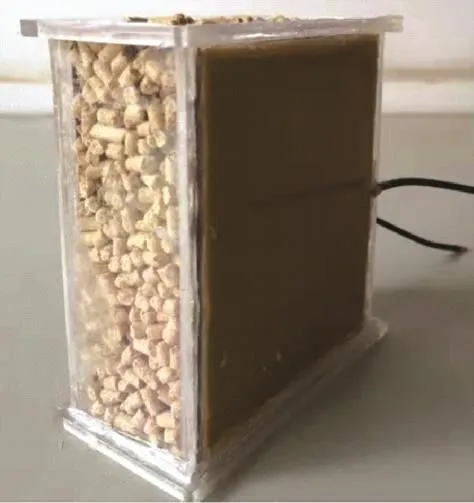
图3 带有电容传感器的料筒
不同含水率的样品其相对介电常数不同,而相对介电常数与电容之间存在线性关系[34],因此可以通过测量样品的电容间接得到其相对介电常数。与常见采用大量分布式电子元件搭建的检测微小电容电路相比,本文采用数字电容转换器AD7745芯片来进行微小电容检测,极大的简化了电路,增强了电容检测的准确、稳定性[35-37]。
AD7745的默认容性动态测量范围为(±4.096) pF,为扩大电容检测范围,就需要设计相应的电容检测范围扩展电路,如图4所示。电容检测范围扩展电路中的运算放大器 AD8515 用作低阻抗信号源,确保AD7745在开始采样时,被检测电容就已经充满电。C1、C33在电路中起去耦作用,C2在电路中起滤波作用。将电容传感器引出的2根屏蔽线锡焊在Csens1和CIN(+)即可。
1.2.2 质量检测模块设计
质量检测模块包含质量传感器及相应的测量电路。其功能是通过检测出电容传感器腔内所盛颗粒饲料质量,再根据电容传感器腔内体积来得到被测颗粒饲料的容积密度。
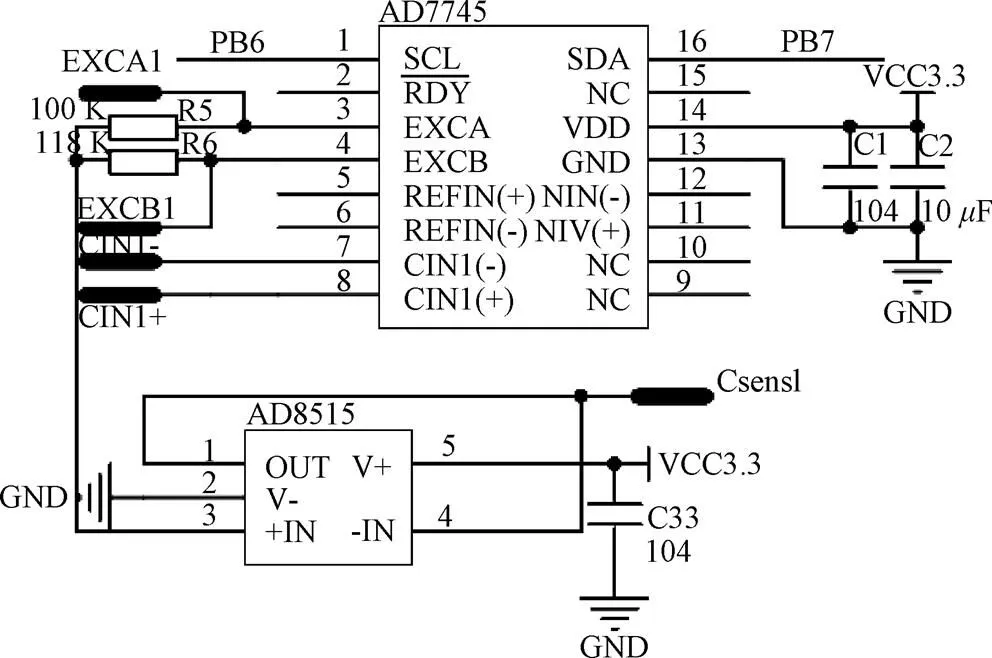
图4 电容检测范围扩展电路
质量传感器选取应变式电阻传感器,量程为5 kg,测量精度为±1 g。电阻应变式质量传感器输出的是mV级的电压信号,这是一种较小的模拟电信号,由于外界信号干扰,单片机直接采集传感器输出电压将产生较大的误差,须经过质量检测电路中的HX711芯片将模拟电信号放大一定的倍数后再转换成数字电信号后,单片机才能够接受、处理。质量检测电路如图5所示。
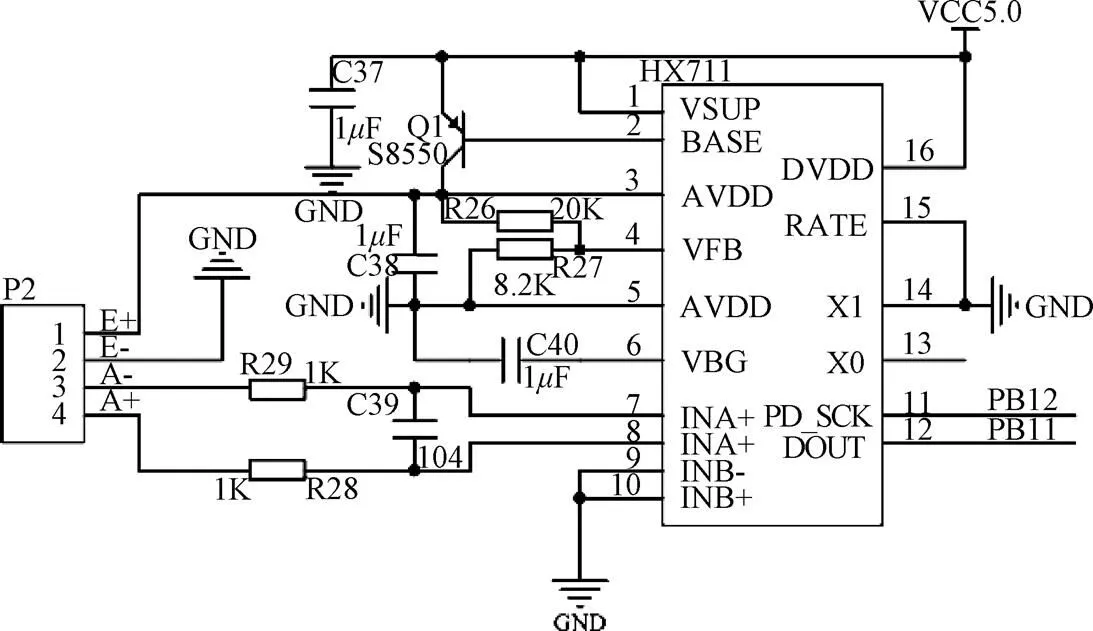
图5 质量检测电路
1.2.3 温度检测模块设计
温度检测模块的作用是检测出被测颗粒饲料样品的温度。温度检测模块采用DS18B20单总线式数字温度传感器,其与单片机通信仅需一个I/O口,即可将颗粒饲料温度转换成数字信号输出。接口电路如图6所示。

图6 DS18B20 接口电路图
1.2.4 信号处理与显示模块设计
为了实现对电容、质量、温度等数据信号的采集与处理,单片机的控制模块设计以STM32最小系统为基础,主要包括STM32F103ZET6芯片、时钟电路、复位电路、下载电路等。控制各功能模块实现操作者意图。显示模块主要采用OLED显示屏,大小为27 mm×26 mm,通过8080并行方式与单片机通信,用于显示颗粒饲料的温度、相对介电常数、容积密度、含水率等。键盘采用4个独立式按键,用来实现不同的显示要求。
1.3 系统检测流程
系统检测主程序流程如图7所示,主要包含电容采集子程序、质量采集子程序、温度采集子程序,含水率计算子程序、按键识别子程序、OLED显示子程序及各主要芯片的初始化。含水率计算子程序是软件设计的关键,直接关系到含水率的检测精度。主要实现的功能是,将转换后的相对介电常数和容积密度和采集到的温度值代入到后续试验得到的相对介电常数与主要影响因素的关系式求解含水率。按键识别子程序主要实现按键识别、被按键功能子程序调用等功能。OLED显示子程序负责被测颗粒饲料样品相对介电常数、容积密度、温度、含水率显示。

图7 系统检测主程序流程图
2 试验与结果分析
2.1 试验材料
试验所用颗粒饲料来自湖北省某大型饲料企业所生产的猪颗粒饲料,直径为3.5 mm。试验前,用筛网筛掉破粒和碎粒,选用颗粒完好、形状大小较均匀的颗粒饲料,装入到密封袋保存。
2.2 试验设备与方法
试验在自主设计的颗粒饲料水分检测仪上进行。采用烘干法(GB/T6435-2014)测定颗粒饲料的初始水分。所用仪器包括DHG-9240A型电热鼓风干燥箱(武汉市环试检测设备有限公司)和AUY220型电子分析天平(日本岛津实验器材有限公司)。试验样品的初始含水率为11.8%。
为了获得不同含水率颗粒饲料样品,使用BT45A10型电子天平(深圳博途电子科技有限公司)称取3份初始含水率的颗粒饲料样品,每份约为1 000 g。将3份样品平摊在托盘中,放入到35 ℃、湿度为80%的RGS-250B型人工气候培养箱(上海市坤天仪器有限公司)内。在高温、高湿的环境下,低水分的颗粒饲料会自动吸收空气中的水分。通过控制颗粒饲料放置在高温、高湿的人工气候箱内的时间长短,就可以获得不同高含水率的颗粒饲料样品。为了得到1组低含水率颗粒饲料样品,取1 000 g初始含水率的颗粒饲料平摊在托盘中,放入到105 ℃干燥箱内,烘干10 min,即可获得低含水率的颗粒饲料样品。直接从颗粒饲料样品原样中称取1 000 g用于试验。试验前,通过烘干法测量得到9.0%、11.8%、14.2%、15.7%、18.0%的颗粒饲料样品。
试验时,先将5种不同含水率的样品放入到35 ℃的烘箱内升温,待样品升到35 ℃取出试验,把各个含水率下的样品以无压实、轻压实、重压实装入颗粒饲料水分检测仪的电容传感器中。无压实状态是将颗粒饲料样品以自由落体方式装满电容传感器。轻压实和重压实是对装填中的样品通过振动和加压来改变容器内的样品质量,从而改变容积密度。不同含水率、压实度下的容积密度如表2所示。
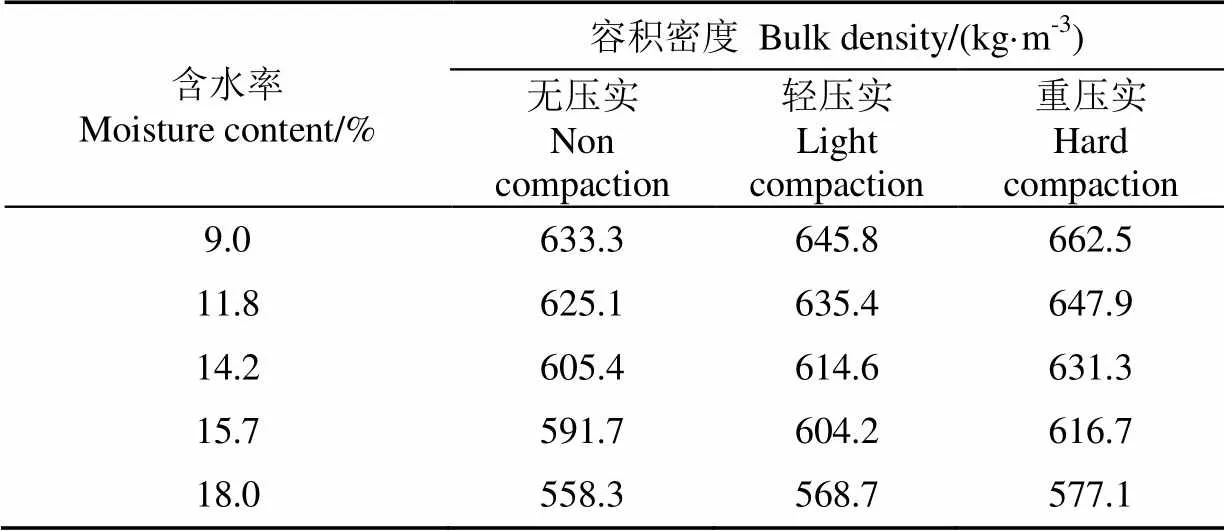
表2 各含水率下颗粒饲料的容积密度值
将装满颗粒饲料样品的检测仪放置到人工气候培养箱内,调节人工气候培养箱的温度,当颗粒饲料样品温度分别降到30、25、20、15、10 ℃时,通过OLED显示屏记录相应的相对介电常数。
2.3 结果与分析
2.3.1 介电常数影响因素分析
图8为无压实状态下,含水率和温度对颗粒饲料相对介电常数的影响规律。由图8可以看出,在含水率增加或温度升高的条件下,颗粒饲料的相对介电常数均呈单调递增的趋势。在高含水率和高温下,颗粒饲料的相对介电常数变化的更为明显。这种现象出现的原因是因为在常温下,水的相对介电常数远远大于颗粒饲料,水在饲料体积中占的比例越大,则相对介电常数就会越大。当温度升高时,会加速饲料内自由水的布朗运动和加速极性分子的取向运动,从而也会使得相对介电常数增加[38]。在轻压实、重压实状态下也有相同的规律。
图9为室温20 ℃下,容积密度对不同含水率颗粒饲料样品相对介电常数的影响。由图9可以看出,在各个含水率下,颗粒饲料的相对介电常数皆随着容积密度的增大而增大。这种现象出现的原因是因为颗粒饲料的容积密度越大,意味着单位体积内可以容纳更多的颗粒饲料,可以存储更多的电场能,从而使相对介电常数增加。该规律也被发现于其他测试温度下。
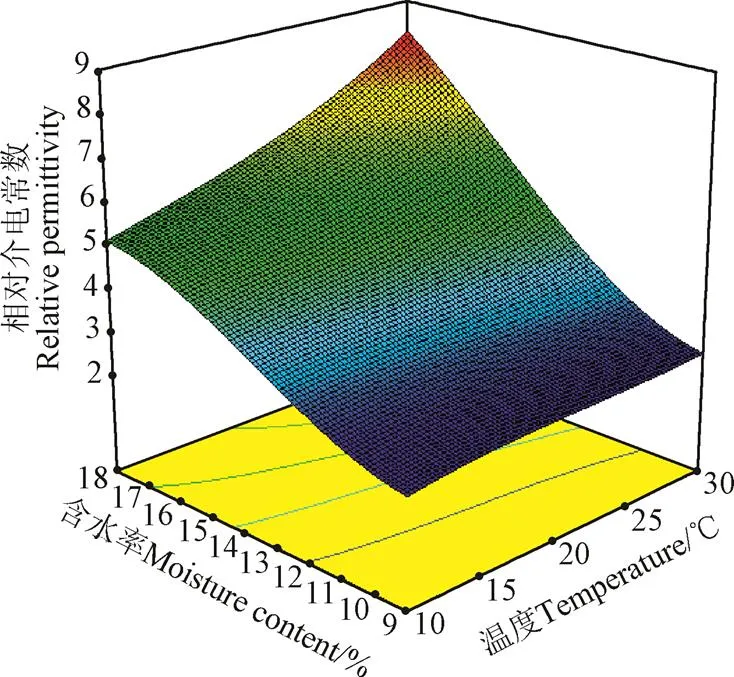
图8 颗粒饲料含水率和温度对相对介电常数的影响

图9 20 ℃下容积密度对颗粒饲料相对介电常数的影响
2.3.2 介电常数模型建立与验证
由2.3.1研究结果可以看出,颗粒饲料的相对介电常数在不同的含水率、温度、容积密度下,有着明显的变化规律。因此,在建立模型时要充分考虑含水率、温度、容积密度对颗粒饲料相对介电常数的影响。使用Design-Expert10软件对试验数据进行多元回归拟合[39],得到关于颗粒饲料相对介电常数与含水率、温度、容积密度之间的一阶模型、2因素交互模型、二阶模型、三阶模型,各模型决定系数见表3。

表3 各模型决定系数
由表3可以看出,在各个模型中,三阶模型的决定系数和预测决定系数最大。所以,采用三阶模型,该模型的拟合回归方程见式(1)

式中′为相对介电常数;为温度,℃;为容积密度,kg/m3;为含水率,%。
为验证式(1)模型的可靠性,随机配制12份含水率在9%~18%之间的颗粒饲料样品,以任意方式装满电容传感器内,容积密度在577.1~633.3 kg/m3,测量在10~30 ℃下的实际相对介电常数。把容积密度、温度、含水率代入式(1)得到预测相对介电常数。
以横坐标为实际相对介电常数,纵坐标为预测相对介电常数。采用一元线性回归的方法,得到实际相对介电常数与预测相对介电常数之间的相关图,如图10所示。
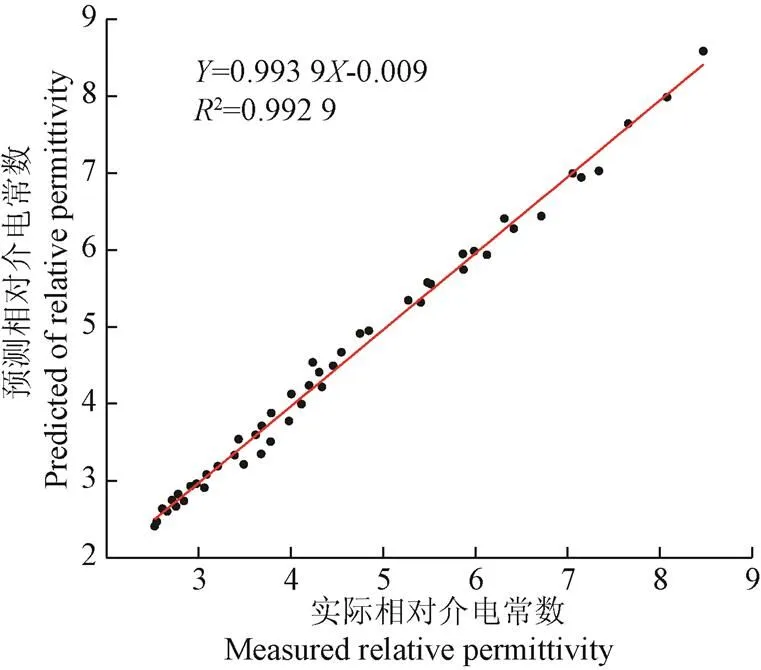
图10 实际相对介电常数与预测相对介电常数相关图
由图10可以看出,实际相对介电常数与预测相对介电常数之间有很好的线性相关性,其决定系数2为0.992 9。表明式(1)能较好的描述相对介电常数与容积密度、温度、含水率的关系。
2.3.3 水分检测仪检测精度验证
将颗粒饲料样品的含水率作为未知量,温度、容积密度、相对介电常数作为已知量,对式(1)进行移项变形,得到式(2)。

在水分检测仪检测到颗粒饲料样品的相对介电常数、温度值、容积密度的情况下,方程就变为一个关于含水率的一元三次方程,采用二分迭代法编写含水率计算的子程序,解出方程的根就是含水率的计算值。
为了检验颗粒饲料水分检测仪测量含水率的准确性,以湖北省某饲料企业生产的猪颗粒饲料为对象,制成6组不同含水率的样品,通过烘干法测量得到的实测值,分别为10.0%、11.6%、13.1%、14.8%、16.8%、17.6%。将不同含水率的样品分成3份,以任意方式装满本文所设计的颗粒饲料水分检测仪,在30、25、20、15、10 ℃下,通过水分检测仪的OLED显示屏读取含水率检测值。
以横坐标为含水率实测值,纵坐标为含水率的检测值。采用一元线性回归的方法,得到含水率实测值与含水率检测值之间的相关图,如图11所示。

图11 颗粒饲料水分检测仪含水率检测值与烘干法含水率测量值相关图
由图11可以看出,含水率实测值与含水率检测值之间有很好的线性相关性,其决定系数为0.990 3。在含水率为9%~18%范围内,本仪器的水分检测误差在±0.6%以内,含水率检测响应时间小于5 s。
3 结 论
1)采用平行极板电容传感器、温度传感器、质量传感器和相应的检测电路等设计了颗粒饲料水分检测仪的硬件系统;采用C语言编写了系统软件。
2)测量了含水率在9%~18%,温度在10~30 ℃,容积密度在558.3~662.5 kg/m3内颗粒饲料样品的相对介电常数,研究颗粒饲料相对介电常数与容积密度、温度、含水率之间的关系,建立颗粒饲料含水率预测模型。结果表明,颗粒饲料相对介电常数随容积密度、温度、含水率的增大而增大;所建立的含水率预测模型的决定系数为0.996 8。经实际验证,该模型能够较好的描述相对介电常数与容积密度、温度、含水率的关系。
3)对颗粒饲料水分检测仪的性能进行验证。结果表明,含水率在9%~18%,温度在10~30 ℃,容积密度在577.1~633.3 kg/m3,与烘干法相比本检测仪的绝对测量误差值在±0.6%以内,含水率检测响应时间小于5 s。
[1] Zhang X, Zhang Y, Chen H, et al. Study on spatial autocorrelation in China’s animal feed industry[J]. New Zealand Journal of Agricultural Research, 2007, 50(5): 831-838.
[2] Fu W G. China’s feed industry in transition: The case of New Hope Group-an industry perspective[J]. Journal of Agribusiness in Developing and Emerging Economies, 2011, 1(2): 162-178.
[3] Abdollahi M R, Ravindran V, Svihus B. Pelleting of broiler diets: An overview with emphasis on pellet quality and nutritional value[J]. Animal Feed Science and Technology, 2013, 179(1/2/3/4): 1-23.
[4] Veizajdelia E, Sala F. The effect of farinose and pellet feed on production parameters of weaned piglets[J]. Macedonian Journal of Animal Science, 2011: 287-291.
[5] Moritz J S, Cramer K R, Wilson K J, et al. Feed manufacture and feeding of rations with graded levels of added moisture formulated to different energy densities[J]. The Journal of Applied Poultry Research, 2003, 12(3): 371-381.
[6] Hott J M, Buchanan N P, Cutlip S E, et al. The effect of moisture addition with a mold inhibitor on pellet quality, feed manufacture, and broiler performance[J]. The Journal of Applied Poultry Research, 2008, 17(2): 262-271.
[7] 孙俊,莫云南,戴春霞,等. 基于介电特性与IRIV-GWO-SVR算法的番茄叶片含水率检测[J]. 农业工程学报,2018,34(14):188-195.
Sun Jun, Mo Yunnan, Dai Chunxia, et al. Detection of moisture content of tomato leaves based on dielectric properties and IRIV-GWO-SVR algorithm[J]. Transactions of the Chinese Society of Agricultural Engineering (Transactions of the CSAE), 2018, 34(14): 188-195. (in Chinese with English abstract)
[8] 商亮,谷静思,郭文川. 基于介电特性及ANN的油桃糖度无损检测方法[J]. 农业工程学报,2013,29(17):257-264.
Shang Liang, Gu Jingsi, Guo Wenchuan. Non-destructively detecting sugar content of nectarines based on dielectric properties and ANN[J].Transactions of the Chinese Society of Agricultural Engineering (Transactions of the CSAE), 2013, 29(17): 257-264. (in Chinese with English abstract)
[9] 沈静波,张海红,吴龙国,等. 基于介电频谱的灵武长枣可溶性固形物含量的预测模型[J]. 农业工程学报,2016,32(增刊2):369:375.
Shen Jingbo, Zhang Haihong, Wu Longguo, et al. LingWu long jujube soluble solids content predicting model research based on dielectric spectra[J].Transactions of the Chinese Society of Agricultural Engineering (Transactions of the CSAE), 2016, 32(Supp.2): 369-375. (in Chinese with English abstract)
[10] 陈晓敏,丰明俊,王力,等. 血液介电参数与血液学指标的相关性分析[J]. 生物医学工程学杂志,2011,28(4):694-697.
Chen Xiaomin, Feng Mingjun, Wang Li, et al. The correlation analysis between dielectric parameters and haematological parameters in whole blood cell[J]. Journal of Biomedical Engineering, 2011, 28(4): 694-697. (in Chinese with English abstract)
[11] 宋文,张敏,吴克宁,等. 潮土区农田土体构型层次的探地雷达无损探测试验[J]. 农业工程学报,2018,34(16):129-138.
Song Wen, Zhang Min, Wu Kening, et al. Test on nondestructive detection of farmland solum structure in fluvo-aquic soil area using ground penetrating radar[J]. Transactions of the Chinese Society of Agricultural Engineering (Transactions of the CSAE), 2018, 34(16): 129-138. (in Chinese with English abstract)
[12] 边红霞,屠鹏. 基于介电参数同步监测苹果静压过程生理变化[J]. 中国食品学报,2019,19(8):279-285.
Bian Hongxia, Tu Peng. The simultaneous monitoring of physiological change of apple based on dielectric parameters in static pressure[J]. Journal of Chinese Institute of Food Science and Technology, 2019, 19(8): 279-285. (in Chinese with English abstract)
[13] 张立彬,胥芳,周国君,等. 苹果的介电特性与新鲜度的关系研究[J]. 农业工程学报,1996,12(3):190-194.
Zhang Libin, Xu Fang, Zhou Guojun, et al. Study on correlations between dielectric properties and freshness of apples[J]. Transactions of the Chinese Society of Agricultural Engineering (Transactions of the CSAE), 1996, 12(3): 186-190. (in Chinese with English abstract)
[14] 沈静波,张海红,马雪莲,等. 基于介电特性的灵武长枣新鲜度预测[J]. 食品与机械,2016,32(1):117-120.
Shen Jingbo, Zhang Haihong, Ma Xuelian, et al. Prediction on fresheness degree of lingwu long jujube on dielectric properties[J]. Food and Machinery, 2016, 32(1): 117-120. (in Chinese with English abstract)
[15] 坎杂,谷趁趁,王丽红,等. 脱绒棉种介电分选参数的优化[J]. 农业工程学报,2010,26(9):114-119.
Kan Za, Gu Chenchen, Wang Lihong, et al. Optimization of parameters for delinted cottonseeds dielectric selection[J]. Transactions of the Chinese Society of Agricultural Engineering (Transactions of the CSAE), 2010, 26(9): 114-119. (in Chinese with English abstract)
[16] 蔡骋,李永超,马惠玲,等. 基于介电特征选择的苹果内部品质无损分级[J]. 农业工程学报,2013,29(21):279-287.
Cai Cheng, Li Yongchao, Ma Huiling, et al. Nondestructive classification of internal quality of applebased on dielectric feature selection[J]. Transactions of the Chinese Society of Agricultural Engineering (Transactions of the CSAE), 2013, 29(21): 279-287. (in Chinese with English abstract)
[17] 王转卫,赵春江,商亮,等. 基于介电频谱技术的甜瓜品种无损检测[J]. 农业工程学报,2017,33(9):290-295.
Wang Zhuanwei, Zhao Chunjiang, Shang Liang, et al. Nondestructive testing of muskmelons varieties based on dielectric spectrum technology[J]. Transactions of the Chinese Society of Agricultural Engineering (Transactions of the CSAE), 2017, 33(9): 290-295. (in Chinese with English abstract)
[18] 唐燕,张继澍. 基于介电特性的猕猴桃和桃果实品种识别研究[J]. 食品科学,2012,33(3):1-4.
Tang Yan, Zhang Jishu. Identification of kiwifruit and peach varieties based on dielectric properties[J]. Food Science, 2012, 33(3): 1-4. (in Chinese with English abstract)
[19] 郭文川,王婧,朱新华. 基于介电特性的燕麦含水率预测[J]. 农业工程学报,2012,28(24):272-279.
Guo Wenchuan, Wang Jing, Zhu Xinhua. Moisture content prediction of oat seeds based on dielectric property[J]. Transactions of the Chinese Society of Agricultural Engineering (Transactions of the CSAE), 2012, 28(24): 272-279. (in Chinese with English abstract)
[20] 于启洋,张付杰,杨薇. 基于介电特性小粒咖啡含水率的检测研究[J]. 农产品加工,2016,12:35-38.
Yu Qiyang, Zhang Fujie, Yang Wei. Predicating moisture content of coffee beans based on dielectric properties[J]. Farm Products Processing, 2016, 12: 35-38. (in Chinese with English abstract)
[21] 桑田,宋春芳,袁冬明,等. 基于微波干燥的黑莓介电特性研究[J]. 浙江农业学报,2016,28(2):345-351.
Sang Tian, Song Chunfang, Yuan Dongming, et al. Dielectric properties of blackberries based on microwave drying[J]. Acta Agriculturae Zhejiangensis, 2016, 28(2): 345-351. (in Chinese with English abstract)
[22] Tan L B, Ji H Y. Study on grain moisture detection system based on the theory of dielectric properties[J]. Applied Mechanics and Materials, 2013, 333/334/335(2): 1558-1563.
[23] 罗承铭,师帅兵. 电容法粮食物料含水率与介电常数关系研究[J]. 农机化研究,2011,33(4):149-151.
Luo Chengming, Shi Shuaibing. Research on the correlation between moisture content and dielectric constant of grain products based on capacitance method[J]. Journal of Agricultural Mechanization Research, 2011, 33(4): 149-151. (in Chinese with English abstract)
[24] Solar M, Solar A. Non-destructive determination of moisture content in hazelnut[J]. Computers & Electronics in Agriculture, 2016, 121: 320-330.
[25] Trabelsi S, Nelson S O, Lewis M A. Microwave nondestructive sensing of moisture content in shelled peanuts independent of bulk density and with temperature compensation[J]. Sensing & Instrumentation for Food Quality & Safety, 2009, 3(2): 114-121.
[26] Sacilik K, Colak A, Tarihi G. Dielectric properties of opium poppy seed[J]. Journal of Agricultural Sciences, 2005(1): 104-109.
[27] Torrealba-Melendez R, Sosa-Morales M E, Olvera-Cervantes J L, et al. Dielectric properties of beans at different temperatures and moisture content in the microwave range[J]. International Journal of Food Properties, 2016, 19(3): 564-577.
[28] 郭文川,王婧,刘驰. 基于介电特性的薏米含水率检测方法研究[J]. 农业机械学报,2012,43(3):113-117.
Guo Wenchuan, Wang Jing, Liu Chi. Predicating moisture content of pearl barley based on dielectric properties[J]. Transactions of the Chinese Society for Agricultural Machinery, 2012, 43(3): 113-117. (in Chinese with English abstract)
[29] 陶志云,刁彩霞. 饲料质量控制过程中水分测定的方法比较[J]. 现代化农业,2010,3:43-44.
[30] Kovaleva A A, Saitov R I, Zaporozhets A S, et al. Microwave moisture meter for cereal gsrains[J]. Measurement Techniques, 2017, 59(10): 1056-1060.
[31] 刘志壮,吕贵勇. 基于电容法的稻谷含水率检测[J]. 农业机械学报,2013,44(7):179-182.
Liu Zhizhuang, Lv Guiyong. Moisture content detection of paddy rice based on capacitance approach[J]. Transactions of the Chinese Society for Agricultural Machinery, 2013, 44(7): 179-182. (in Chinese with English abstract)
[32] 赵丽清,尚书旗,高连兴,等. 基于同心轴圆筒式电容传感器的花生仁水分无损检测技术[J]. 农业工程学报,2016,32(9):212-218.
Zhao Liqing, Shang Shuqi, Gao Lianxing, et al. Nondestructive measurement of moisture content of peanut kernels based on concentric cylindrical capacitance[J]. Transactions of the Chinese Society of Agricultural Engineering (Transactions of the CSAE), 2016, 32(9): 212-218. (in Chinese with English abstract)
[33] 郭文川,赵志翔,杨沉陈. 基于介电特性的小杂粮含水率检测仪设计与试验[J]. 农业机械学报,2013,44(5):188-193.
Guo Wenchuan, Zhao Zhixiang, Yang Chenchen. Moisture meter for coarse cereals based on dielectric psroperties[J]. Transactions of the Chinese Society for Agricultural Machinery, 2013, 44(5): 188-193. (in Chinese with English abstract)
[34] Carlos M, Luisa G F, Alfonso G, et al. Measurement of moisture in wood for application in the restoration of old buildings[J]. Sensors, 2016, 16(5): 697-706.
[35] Zhao L Q, Wang D W, Yin Y Y, et al. Design of a peanut moisture detector based on STM32 and MATLAB[J]. Emirates Journal of Food and Agriculture, 2018, 30(10): 893-902.
[36] 郭文川,刘驰,杨军. 小麦秸秆含水率测量仪的设计与试验[J]. 农业工程学报,2013,29(1):33-40.
Guo Wenchuan, Liu Chi, Yang Jun. Design and experiment on wheat straw moisture content meter[J]. Transactions of the Chinese Society of Agricultural Engineering (Transactions of the CSAE), 2013, 29(1): 33-40. (in Chinese with English abstract)
[37] 周利明,张小超,苑严伟. 小麦播种机电容式排种量传感器设计[J]. 农业工程学报,2010,26(10):99-103.
Zhou Liming, Zhang Xiaochao, Yuan Yanwei. Design of capacitance seed rate sensor of wheat planter[J]. Transactions of the Chinese Society of Agricultural Engineering (Transactions of the CSAE), 2010, 26(10): 99-103. (in Chinese with English abstract)
[38] Wang S, Monzon M, Gazit Y, et al. Temperature-dependent dielectric properties of selected subtropical and tropical fruits and associated insect pests[J]. Transactions of the ASAE, 2005, 48(5): 1873-1881.
[39] 葛宜元. 试验设计方法与Design-Expert软件应用[M]. 哈尔滨市:哈尔滨工业大学出版社,2014:81-85.
Design of dielectric pellet feed moisture detector based on parallel plate capacitance sensor
Niu Zhiyou1,2, Liu Fanghong1, Liu Ming1, Ren Zouhong1, Li Pei1
(1.,,430070,; 2.430070,)
The moisture content of pellet feed directly affects the quality of pellet feed. At present, the drying method is widely used for the detection of moisture in pellet feed. The shortcomings of this method are long detection time and single detection means. In order to increase the pellet feed moisture detection method and realize the non-destructive detection of pellet feed moisture, the STM32F103ZET6 single-chip microcomputer was used as the control chip for the pellet feed moisture detector, which mainly included the capacitance detection module, the temperature detection module and the weight detection module. The capacitance detection module uses parallel plate capacitance sensor and range expansion detection circuit with a digital capacitor converter AD7745 chip as the core. The weight detection module uses a strain resistance sensor and an A/D conversion circuit whose core is HX711 chip. The temperature detection module uses DS18B20 temperature sensor. After the initialization of each module, the capacitance, weight and temperature of the tested sample were sequentially collected, and the capacitance and weight therein were converted into relative permittivity and bulk density. The obtained relative permittivity, bulk density, and temperature were substituted into a moisture content calculation subroutine based on the binary iterative method to obtain a moisture content detection value of the sample and the detection result was displayed on the OLED display. The self-made pellet feed moisture detector was used to analyze the influence of moisture content (9%~18%), temperature (10~30 ℃) and bulk density (558.3~662.5 kg/m3) on the relative permittivity of pellet feed. The prediction model between relative permittivity and moisture content, temperature and bulk density was established. 12 samples of pellet feed with moisture content ranging from 9% to 18% were randomly prepared. The actual relative permittivity at different temperatures was measured by filling the capacitance sensor in any way. Then, the bulk density, temperature, and moisture content were substituted into the established model to obtain the predicted relative permittivity. The actual relative permittivity was compared with the predicted relative permittivity to verify the prediction effect of the established model. The detection accuracy of the dielectric pellet feed moisture detector based on the parallel plate capacitive sensor was tested. The results showed that the relative permittivity of pellet feed increased with the increase of temperature, moisture content and bulk density. The determination coefficient of the established relative permittivity and moisture content, temperature and bulk density model was 0.996 8. There was a good linear correlation between the measured relative permittivity and the predicted relative permittivity, the coefficient of determination was 0.992 9, indicating that the established model could describe the relative permittivity and bulk density, temperature and moisture content relationship well; The coefficient of determination between the measured value of the moisture content of the pellet feed and the detected value of the designed detector was 0.990 3. Compared with the drying method, the absolute measurement error of the measured value and the detected value was within ±0.6%. The research provides a new method and technical support for fast and non-destructive on-line detection of pellet feed moisture content.
nondestructive detection; moisture content; sensor; capacitance sensor; pellet feeds; detector; dielectric properties
牛智有,刘芳宏,刘 鸣,任邹弘,李 培. 平行极板电容传感器介电式颗粒饲料水分检测仪设计与试验[J]. 农业工程学报,2019,35(18):36-43.doi:10.11975/j.issn.1002-6819.2019.18.005 http://www.tcsae.org
Niu Zhiyou, Liu Fanghong, Liu Ming, Ren Zouhong, Li Pei. Design of dielectric pellet feed moisture detector based on parallel plate capacitance sensor[J]. Transactions of the Chinese Society of Agricultural Engineering (Transactions of the CSAE), 2019, 35(18): 36-43. (in Chinese with English abstract) doi:10.11975/j.issn.1002-6819.2019.18.005 http://www.tcsae.org
2019-05-10
2019-08-28
中央高校基本科研业务费专项资金资助项目(2662018PY081)
牛智有,教授,博士生导师,研究方向:从事农产品加工技术与装备。Email:nzhy@mail.hzau.edu.cn
10.11975/j.issn.1002-6819.2019.18.005
S237
A
1002-6819(2019)-18-0036-08

